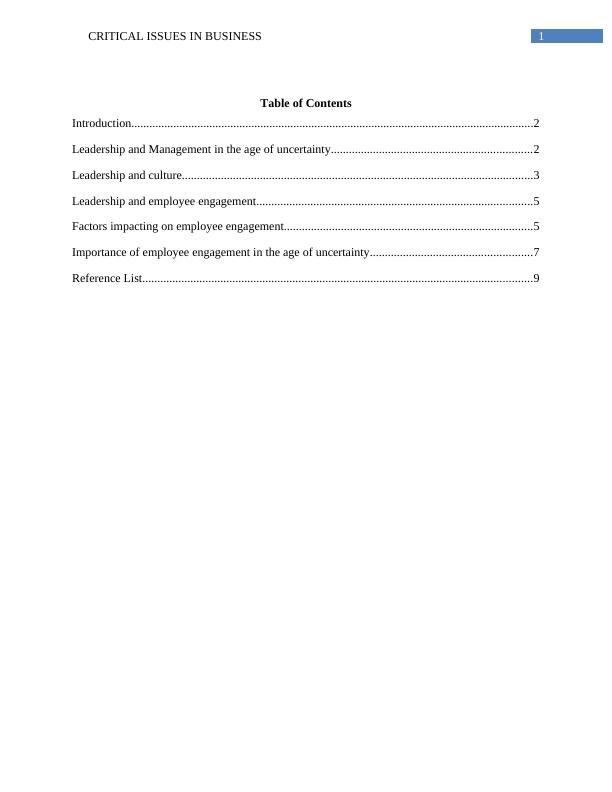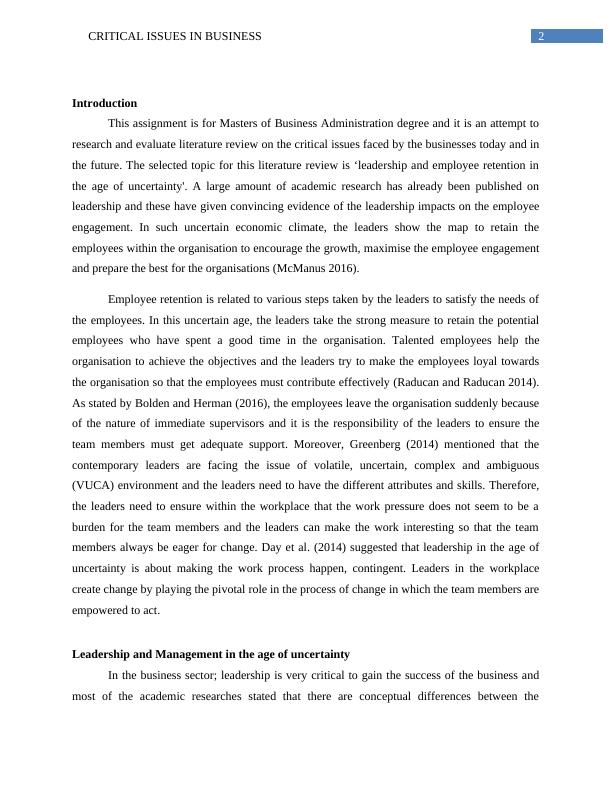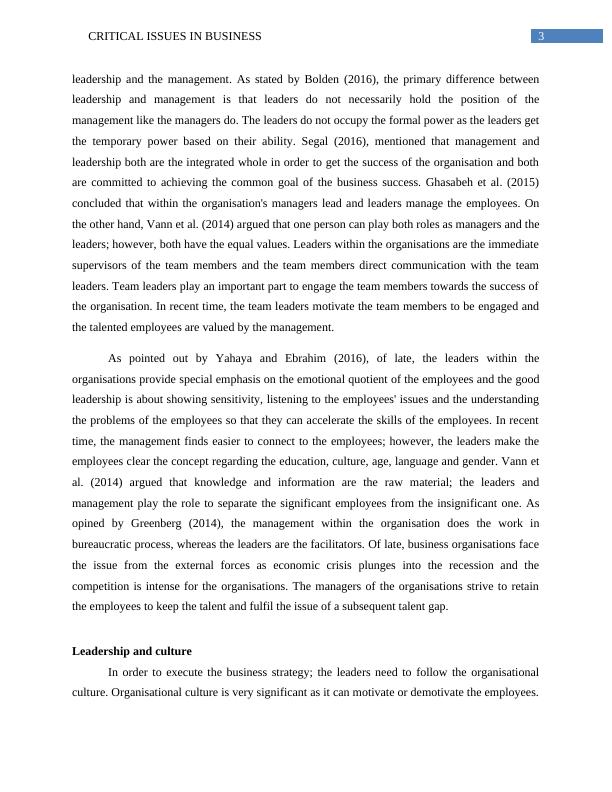Leadership and Employee Retention in the Age of Uncertainty
Added on 2023-06-11
13 Pages4078 Words59 Views
Running head: CRITICAL ISSUES IN BUSINESS
Critical Issues in Business
MODULE: STRM042 Critical Issues in Business
Strategic Development of Organisations in the Age of Uncertainty
Topic: Leadership and Employee retention in the Age of Uncertainty
Student’s name:
Name of the university:
Author’s note:
Critical Issues in Business
MODULE: STRM042 Critical Issues in Business
Strategic Development of Organisations in the Age of Uncertainty
Topic: Leadership and Employee retention in the Age of Uncertainty
Student’s name:
Name of the university:
Author’s note:

1CRITICAL ISSUES IN BUSINESS
Table of Contents
Introduction......................................................................................................................................2
Leadership and Management in the age of uncertainty...................................................................2
Leadership and culture.....................................................................................................................3
Leadership and employee engagement............................................................................................5
Factors impacting on employee engagement...................................................................................5
Importance of employee engagement in the age of uncertainty......................................................7
Reference List..................................................................................................................................9
Table of Contents
Introduction......................................................................................................................................2
Leadership and Management in the age of uncertainty...................................................................2
Leadership and culture.....................................................................................................................3
Leadership and employee engagement............................................................................................5
Factors impacting on employee engagement...................................................................................5
Importance of employee engagement in the age of uncertainty......................................................7
Reference List..................................................................................................................................9

2CRITICAL ISSUES IN BUSINESS
Introduction
This assignment is for Masters of Business Administration degree and it is an attempt to
research and evaluate literature review on the critical issues faced by the businesses today and in
the future. The selected topic for this literature review is ‘leadership and employee retention in
the age of uncertainty'. A large amount of academic research has already been published on
leadership and these have given convincing evidence of the leadership impacts on the employee
engagement. In such uncertain economic climate, the leaders show the map to retain the
employees within the organisation to encourage the growth, maximise the employee engagement
and prepare the best for the organisations (McManus 2016).
Employee retention is related to various steps taken by the leaders to satisfy the needs of
the employees. In this uncertain age, the leaders take the strong measure to retain the potential
employees who have spent a good time in the organisation. Talented employees help the
organisation to achieve the objectives and the leaders try to make the employees loyal towards
the organisation so that the employees must contribute effectively (Raducan and Raducan 2014).
As stated by Bolden and Herman (2016), the employees leave the organisation suddenly because
of the nature of immediate supervisors and it is the responsibility of the leaders to ensure the
team members must get adequate support. Moreover, Greenberg (2014) mentioned that the
contemporary leaders are facing the issue of volatile, uncertain, complex and ambiguous
(VUCA) environment and the leaders need to have the different attributes and skills. Therefore,
the leaders need to ensure within the workplace that the work pressure does not seem to be a
burden for the team members and the leaders can make the work interesting so that the team
members always be eager for change. Day et al. (2014) suggested that leadership in the age of
uncertainty is about making the work process happen, contingent. Leaders in the workplace
create change by playing the pivotal role in the process of change in which the team members are
empowered to act.
Leadership and Management in the age of uncertainty
In the business sector; leadership is very critical to gain the success of the business and
most of the academic researches stated that there are conceptual differences between the
Introduction
This assignment is for Masters of Business Administration degree and it is an attempt to
research and evaluate literature review on the critical issues faced by the businesses today and in
the future. The selected topic for this literature review is ‘leadership and employee retention in
the age of uncertainty'. A large amount of academic research has already been published on
leadership and these have given convincing evidence of the leadership impacts on the employee
engagement. In such uncertain economic climate, the leaders show the map to retain the
employees within the organisation to encourage the growth, maximise the employee engagement
and prepare the best for the organisations (McManus 2016).
Employee retention is related to various steps taken by the leaders to satisfy the needs of
the employees. In this uncertain age, the leaders take the strong measure to retain the potential
employees who have spent a good time in the organisation. Talented employees help the
organisation to achieve the objectives and the leaders try to make the employees loyal towards
the organisation so that the employees must contribute effectively (Raducan and Raducan 2014).
As stated by Bolden and Herman (2016), the employees leave the organisation suddenly because
of the nature of immediate supervisors and it is the responsibility of the leaders to ensure the
team members must get adequate support. Moreover, Greenberg (2014) mentioned that the
contemporary leaders are facing the issue of volatile, uncertain, complex and ambiguous
(VUCA) environment and the leaders need to have the different attributes and skills. Therefore,
the leaders need to ensure within the workplace that the work pressure does not seem to be a
burden for the team members and the leaders can make the work interesting so that the team
members always be eager for change. Day et al. (2014) suggested that leadership in the age of
uncertainty is about making the work process happen, contingent. Leaders in the workplace
create change by playing the pivotal role in the process of change in which the team members are
empowered to act.
Leadership and Management in the age of uncertainty
In the business sector; leadership is very critical to gain the success of the business and
most of the academic researches stated that there are conceptual differences between the

3CRITICAL ISSUES IN BUSINESS
leadership and the management. As stated by Bolden (2016), the primary difference between
leadership and management is that leaders do not necessarily hold the position of the
management like the managers do. The leaders do not occupy the formal power as the leaders get
the temporary power based on their ability. Segal (2016), mentioned that management and
leadership both are the integrated whole in order to get the success of the organisation and both
are committed to achieving the common goal of the business success. Ghasabeh et al. (2015)
concluded that within the organisation's managers lead and leaders manage the employees. On
the other hand, Vann et al. (2014) argued that one person can play both roles as managers and the
leaders; however, both have the equal values. Leaders within the organisations are the immediate
supervisors of the team members and the team members direct communication with the team
leaders. Team leaders play an important part to engage the team members towards the success of
the organisation. In recent time, the team leaders motivate the team members to be engaged and
the talented employees are valued by the management.
As pointed out by Yahaya and Ebrahim (2016), of late, the leaders within the
organisations provide special emphasis on the emotional quotient of the employees and the good
leadership is about showing sensitivity, listening to the employees' issues and the understanding
the problems of the employees so that they can accelerate the skills of the employees. In recent
time, the management finds easier to connect to the employees; however, the leaders make the
employees clear the concept regarding the education, culture, age, language and gender. Vann et
al. (2014) argued that knowledge and information are the raw material; the leaders and
management play the role to separate the significant employees from the insignificant one. As
opined by Greenberg (2014), the management within the organisation does the work in
bureaucratic process, whereas the leaders are the facilitators. Of late, business organisations face
the issue from the external forces as economic crisis plunges into the recession and the
competition is intense for the organisations. The managers of the organisations strive to retain
the employees to keep the talent and fulfil the issue of a subsequent talent gap.
Leadership and culture
In order to execute the business strategy; the leaders need to follow the organisational
culture. Organisational culture is very significant as it can motivate or demotivate the employees.
leadership and the management. As stated by Bolden (2016), the primary difference between
leadership and management is that leaders do not necessarily hold the position of the
management like the managers do. The leaders do not occupy the formal power as the leaders get
the temporary power based on their ability. Segal (2016), mentioned that management and
leadership both are the integrated whole in order to get the success of the organisation and both
are committed to achieving the common goal of the business success. Ghasabeh et al. (2015)
concluded that within the organisation's managers lead and leaders manage the employees. On
the other hand, Vann et al. (2014) argued that one person can play both roles as managers and the
leaders; however, both have the equal values. Leaders within the organisations are the immediate
supervisors of the team members and the team members direct communication with the team
leaders. Team leaders play an important part to engage the team members towards the success of
the organisation. In recent time, the team leaders motivate the team members to be engaged and
the talented employees are valued by the management.
As pointed out by Yahaya and Ebrahim (2016), of late, the leaders within the
organisations provide special emphasis on the emotional quotient of the employees and the good
leadership is about showing sensitivity, listening to the employees' issues and the understanding
the problems of the employees so that they can accelerate the skills of the employees. In recent
time, the management finds easier to connect to the employees; however, the leaders make the
employees clear the concept regarding the education, culture, age, language and gender. Vann et
al. (2014) argued that knowledge and information are the raw material; the leaders and
management play the role to separate the significant employees from the insignificant one. As
opined by Greenberg (2014), the management within the organisation does the work in
bureaucratic process, whereas the leaders are the facilitators. Of late, business organisations face
the issue from the external forces as economic crisis plunges into the recession and the
competition is intense for the organisations. The managers of the organisations strive to retain
the employees to keep the talent and fulfil the issue of a subsequent talent gap.
Leadership and culture
In order to execute the business strategy; the leaders need to follow the organisational
culture. Organisational culture is very significant as it can motivate or demotivate the employees.

End of preview
Want to access all the pages? Upload your documents or become a member.
Related Documents
Essay on Strategic Development of Organisationslg...
|10
|3083
|48
Critical Issue in Business and Management Assignmentlg...
|13
|3671
|115
STRM042 Critical Issues in Businesslg...
|15
|3707
|61
Team Dynamics and Leadership: A Reflection on PechaKucha Presentationlg...
|10
|2312
|261
Leadership and Management: Tips for Team Involvement, Meeting Minutes, Performance Plans, Communication Policy, and Morelg...
|12
|610
|103
To Identify the Impact of Leadership Style on Staff Retentionlg...
|6
|1068
|44
